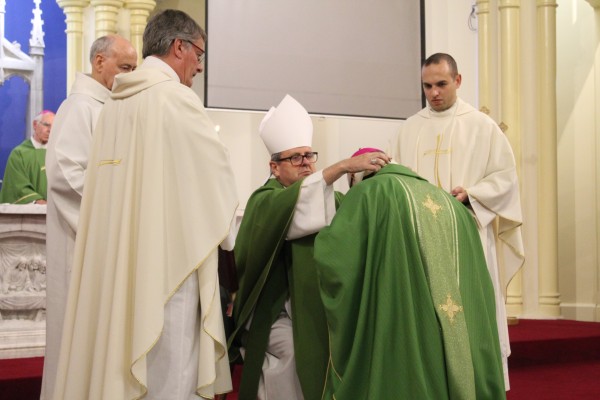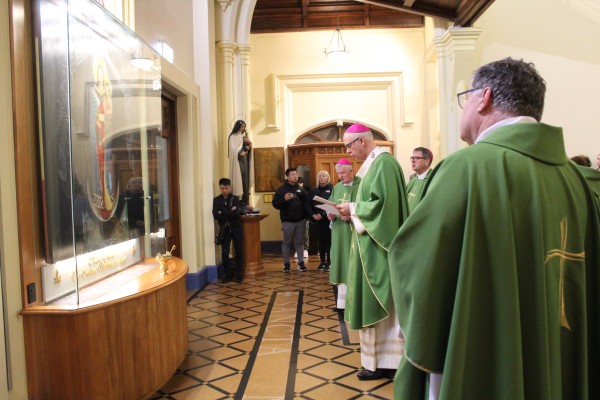


Archbishop of Wellington Paul Martin SM received his Metropolitan Archbishop’s pallium and also blessed the iconic Holy Mary Mother of God artwork during the same 5pm Mass at St Mary of the Angels church in Wellington on Sunday 5 November.
The pallium – a white band of lamb’s wool adorned with black crosses and worn over the shoulders and chasuble – is the traditional, historic insignia of a metropolitan archbishop of the Catholic Church and is bestowed by the Pope.
“It’s an ancient part of our Church tradition and I am extremely humble wearing it today,” Archbishop Martin told the crowded church in his homily during the Mass.
A metropolitan archbishop wears the pallium whenever he is present at a liturgical ceremony as Metropolitan. He also wears it for archdiocesan ceremonies such as the Chrism Mass and any major ceremonies at the Metropolitan Cathedral.
Archbishop Martin was installed as Archbishop of Wellington on 17 June, replacing Cardinal John Dew, who retired in May. Archbishop Martin had been expecting to receive the pallium from the Papal Nuncio, Archbishop Novatus Rugambwa. But Archbishop Rugambwa – the Pope’s diplomatic representative in New Zealand – suffered a stroke on 27 October and is in Wellington Hospital. Therefore, Archbishop Martin chose the Bishop of Auckland, Stepehen Lowe, to confer the pallium.
The rite was simple. After the formal process into the church, Bishop Lowe sat in a chair in front of the altar. Archbishop Martin knelt before him, professing his faith and taking the oath of fidelity. Bishop Lowe then placed the pallium over Archbishop Martin’s shoulders. The Mass followed in the normal way, with Archbishop Martin presiding.
Archbishop Martin said in his homily that he had returned only on Thursday night from Rome, where for the past month he had been part of the Synod on Synodality, staying in the same Vatican guest house as Pope Francis and seeing the Pope up close many times. Church people from many countries were part of the Synod, a constant reminder that the Catholic Church covered the whole world.
“The pallium represents the unity of the Church coming from the apostolic succession of St Peter. The Metropolitan has some particular roles to play under the pastoral authority of the Pope. It’s an ancient part of our Church tradition and I am extremely humble wearing it today.”
Five of the country’s six Catholic bishops took part in the Mass. With Archbishop Martin and Bishop Lowe were Bishop-elect Richard Laurenson (Hamilton; he will be ordained on 8 December), Bishop John Adams (Palmerston North) and Bishop Michael Dooley (Dunedin). At the conclusion of the Mass, they processed to the back of the church, where the icon artwork Ko Hāta Maria, te Matua Wahine o te Atua-Holy Mary, Mother of God, by Damien Walker (Studio of Saint Philomena, Rangiora) has been installed, for Archbishop Martin to bless the artwork.
The bishops commissioned the artwork during the Covid-19 pandemic as part of their rededication of Aotearoa New Zealand to the protection of Mary Assumed into Heaven. St Mary of the Angels has been declared a National Shrine to Mary with the artwork as its centrepiece.
Notes regarding the pallium
Courtesy Fr Patrick Bridgman, Liturgy Advisor, Archdiocese of Wellington
The pallium, made of lamb’s wool, is a white band measuring about 5 cm in width. Two equally wide bands, about 30 cm long containing small silk-covered lead pieces, extend one in front and one on the back. It is worn over the chasuble and is the insignia of the office of the Metropolitan Archbishop, that is, of an archbishop who is the bishop of a metropolitan archdiocese. Six black crosses adorn the pallium and are placed in the front and back, on each shoulder, and on the ends of the pieces hanging in front and back. The crosses on the front, on the back, and on the left shoulder also bear a pin, called a spinula (a Latin word meaning a small spine, or thorn).
Currently, every year, on the feast of St Agnes (21 January), two lambs are brought from Tre Fontane, the site of St Paul’s martyrdom, to the Basilica of St Agnes on the Via Nomentana in Rome. After the lambs are blessed, they are taken and presented to the Pope. They then remain in the care of the Sisters who reside at the Basilica of St Cecilia in Trastevere in Rome. Just before Easter, these lambs are shorn, and their wool is used in making the palliums for newly-appointed metropolitan archbishops. Once entirely handmade by the Sisters, the sheer number of archbishops in need of a pallium each year now has made it impossible to continue with that practice. Instead, the Sisters select a company to manufacture them. Each pallium contains a portion of the wool shorn from the two lambs.
In the history of the Archdiocese of Wellington, Cardinal Reginald Delargy received his pallium at the 75th Jubilee of Holy Cross College, the National Seminary in Mosgiel, Dunedin. Cardinal Tom Williams’ pallium arrived by mail, while Cardinal John Dew received his by the hands of Pope Francis on the Feast of Saints Peter and Paul in Rome. Pope Francis has more recently returned to the tradition of blessing the palliums on that feast day and sending them to the papal nuncio in each country for the nuncio to confer upon the local Metropolitan Archbishop at a suitable moment.
Photos: By David McLoughlin